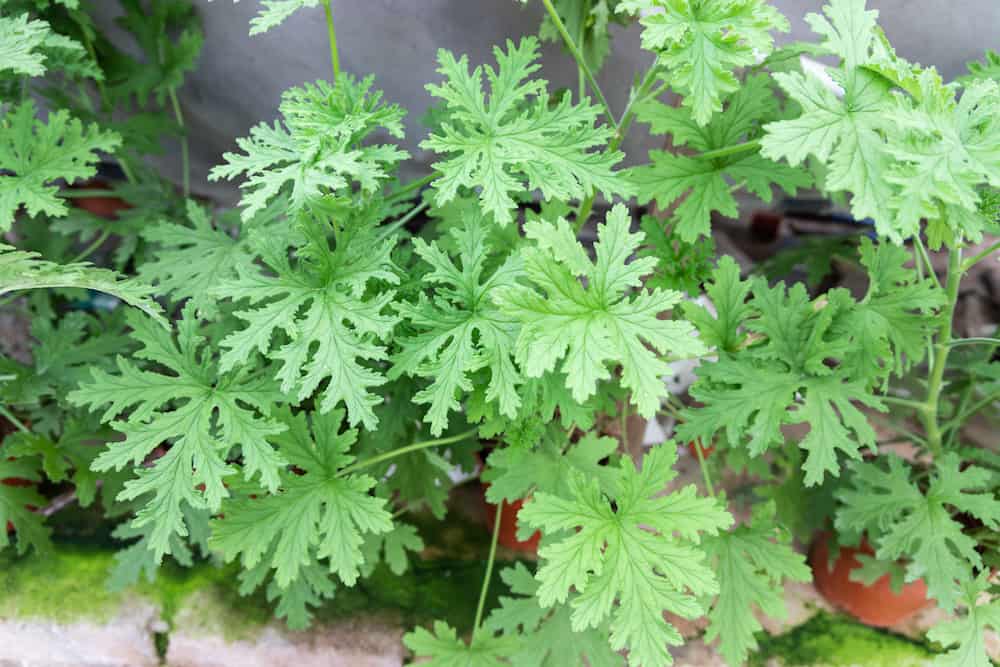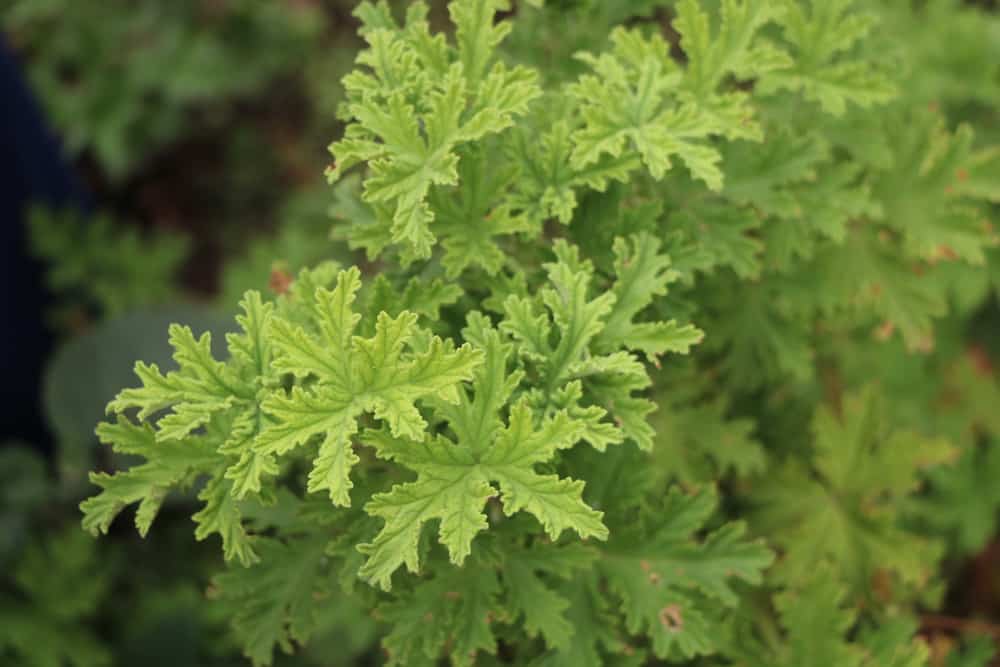Here’s what to know about growing and using a citronella plant. If only there were some way to limit the unrelenting nuisance that plagues all our summertime fun: the mosquito. Getting rid of mosquitoes is an everyday battle during the summer.
While known to be a nuisance in the summer, mosquitos are common in the fall. Expect them around until temperatures are consistently lower than 50 degrees F.
First eliminate standing water. If you have a rainwater collection system, be sure it’s completely enclosed. Spraying yourself down with insect repellent is another way to ensure you don’t get bitten by the pests, but not the most cost-effective solutions.
Fortunately, there is the citronella plant: nature’s gift to humanity to repel mosquitoes!
However, two plants share that quintessential citronella smell and chances are you are getting them confused.
We take a look at the differences between the two, as well as how to grow your very own citronella at home!
Citronella vs. Mosquito Plant
It can be a bit confusing when you learn that there are, in fact, two plants called citronella.
We tend to recognize it by its citrus-like scent, but these plants are two different species entirely.
Citronella
There are a few different varieties of plants known as citronella.
True citronella is a grass, which can be very effective at repelling mosquitoes.
It is native to the tropics of Asia but can be grown in more northern climates.
The plant itself does not repel mosquitoes. It is the oil inside the grass leaves that possesses repellent properties.
Mosquito Plant
Contrary to its name, mosquito plants are not actually mosquito repellent.
They are a variety of geranium with lacy leaves that smell like citronella but do not have the same oils as the grass.
Thus, they have a delightful scent but are not as effective at repelling insects.
The mosquito plant is larger and will take up more room in your garden.
It produces sweet-smelling, beautiful purple flowers that add a nice touch to any summertime arrangement.
What Are the Benefits of Citronella?
The citronella grass has many beneficial properties, such as:
1. Insect Repellent
Citronella not only repels mosquitoes but other flies as well. It is also used throughout Asia to get rid of lice.
However, as mentioned, it is the oils inside the grass, not the plant itself that is useful for this purpose.
How to Make Repellent
To make a citronella-based repellent, you must extract the oils, which can be done simply by crushing the plant leaves.
You can rub it directly on the skin or make large quantities of the concentrate for later use.
Both, when applied on the skin or clothes can help repel moquitoes for up to 12 hours.
If you want large quantities of oil, place the leaves in a pressure cooker or slow cooker along with a cup or so of olive oil.
Turn on your cooker and let the mixture cook for at least four hours.
Allow to cool down and place it in a clean glass bottle.
You can also maximize the use of your homemade citronella oil by making a diluted insect repellent, but do note that its effect can only last for up to two hours.
Thus, you’ll have to re-apply it more often than the concentrated one.
You can also make citronella oil candles that you can place in your outdoor and indoor living space for a mosquito-free environment for everyone.
Insect Repellent Spray
What you need to do is to place two ounces of distilled or boiled water and one ounce of vodka in a four-ounce spray bottle.
Add 50 to 75 drops of your homemade citronella oil, and then close the bottle. Shake, and you’re done!
Candle
For your DIY citronella oil candle, here are the things you’d need:
- Old but clean cans, mason jars, or any item that can hold meted wax
- A gluing device or tape
- A double boiler
- Paraffin, soy, or old candle wax (note its weight in pounds)
- Wicks with tabs
- Citronella oil
Here are the steps you need to follow:
- For each jar or can, secure the wicks with the help of strong tape or hot glue.
- If the wax comes in blocks or blocks, you should cut them into small flakes so that they melt quickly and evenly.
- Place the flaked or cut-out wax in a double boiler.
- Switch your stove on, at medium heat, and wait for the wax to melt completely.
- For every pound of wax used, add one ounce of your homemade citronella oil. Mix.
- Let it cool a bit. Don’t allow it to solidify!
- Slowly pour the liquid mixture to each of your cans or jars with wicks.
- Leave them in a cool, dry place for at least 48 hours for them to solidify completely.
- Cut the excess wicks, if you want to, and light them up anytime!
2. Medicine
Citronella has also been found to have medicinal properties.
The best way to reap the medicinal benefits of citronella oil is to combine the grass leaves with oil (as above), or buy it in a store or online.
The leaves from citronella have been shown to help reduce fevers and alleviate pain associated with migraines and other tension.
Citronella also has anti-bacterial, anti-fungal, and anti-inflammatory properties, so it is great for a wide range of different ailments.

How to Plant Citronella
Citronella can be planted in containers or the garden, but we will explore the method for planting citronella in your garden directly.
Keep in mind that you will need to decide whether you plant the grass or the geranium, but the process is basically the same for each!
1. Find the Right Spot
The best place in your garden will be somewhere that gets some afternoon shade but still receives sunlight in the morning.
Planting citronella beneath a tree is also a good idea for limiting the harmful UV rays.
2. Ensure Proper Plant Spacing
If you are planting citronella directly in the ground, make sure you space your plants 18 to 24 inches apart to prevent overcrowding.
3. Plant at the Right Time
Citronella prefers to be planted in the spring, just after the last frost.
Since citronella is native to the tropics, it does not do well in cold conditions and will most likely die if they encounter frost.
It’s a safe bet to plant your citronella at the same time you plant your tomatoes.
4. Use Quality Soil
When planting citronella, use good quality soil and mix it with a bit of organic compost to help it flourish.
If you do not have access to your own compost, there are also quite a few good options on the market for high-quality, all-purpose soil.
5. Remember to Water
Citronella requires a lot of water, so you need to water it every day to make sure it doesn’t dry out.
You will be able to tell if your plant is not getting enough water because it will try to spread itself out more and will also start to wilt.
5. Practice End-of-Season Citronella Plant Care
When summer comes to an end, you will need to prevent your citronella from dying off.
In climates with harsh winters, citronella will be planted annually.
On the other hand, in milder climates, your citronella can actually be a perennial, in which case, you should take proper precautions to keep it safe until spring.
6. Propagate a New Plant
Before summer is officially over, you can propagate new citronella, which will last until spring.
This is a good idea as it means you don’t have to start the process all over again each year.
You can have your plant ready for when mosquito season is in full swing.
Step One
Get a new, large pot and fill it with good quality soil. Set it beside your big citronella in the garden.
Step Two
Grab a stem that is still attached to the plant and bend it into the soil of the new pot.
Bury the stem sideways, making sure to bury at least one nodule where a leaf is attached.
You want the leaf node buried but the top of the stem exposed.
You can use a rock as a placeholder and put it over the buried part of the stem.
Step Three
It will take a few weeks for the stem to throw down roots, but by the time the season is finished, it established itself.
Cut the propagated stem free from the original plant and move the new plant inside to wait out the winter.
FAQs About Citronella and Mosquito Plants
1. Is Citronella Plant and Lemongrass the Same?
They have similar smells and can be used in similar ways, but citronella and lemongrass are not the same.
The best way to tell them apart is by the color. Citronella will have a reddish tint to its stem, whereas lemongrass will be all green.
2. Is Citronella Plant Edible?
Yes, you can use citronella in a variety of dishes. Since the plant originates in Asia, it is a popular ingredient in stir-fries and curries.
By drying out the plant, you can use it as an excellent spice to add a little citrus flavor to any dish.
3. Do Citronella Plants Need Full Sun?
Yes and no. Citronella needs the bright sun, but for the best citronella plant care, place them in a spot where harsh afternoon rays will be filtered.
Too much direct sunlight will burn the plant.
4. Do Citronella Plants Work Against Mosquitoes?
Citronella grass is very effective against mosquitoes and other insects.
However, the geranium variety of citronella will not repel mosquitoes.
It doesn’t have the same properties as the grass, but does have the same lovely citrus smell and is great decoration.
5. What Can I Use My Mosquito Plant For?
Even though your mosquito plant will not directly repel mosquitoes, it will still make an excellent addition to your garden.
Some of our favorite ideas for using the mosquito plant are the following:
Decorative Bouquets
For summertime gatherings with family and friends, make up a bouquet of the flowers from your mosquito plant to use as a table decoration.
Mosquito plants have beautiful purple flowers that will add a lovely color to any setting.
Fragrance Boosts
You can spread mosquito plant cuttings around your house to add a lovely citrus scent to any room.
Combine your citronella flowers with other summertime flowers for an exquisite blend of aromas.
Citronella Plant Usefulness
Although citronella and mosquito plants are different in some ways, they’re both useful.
Making use of their unique properties can highly benefit you and your home. If you want a multi-purpose plant, though, citronella will be the best choice, especially for pesky insects!
Purple Tulips ~ Guide to Growing Your Own Thriving Beautiful Tulips
Soybean Plant Growing, Uses and Needs

